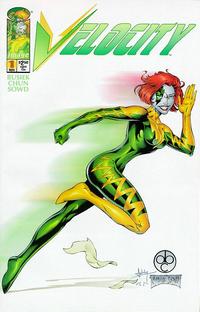 This weekend I read the 3-issue Velocity miniseries from 1995, by Kurt Busiek and Anthony Chun. I’m not terribly familiar with the character, having read only the Pilot Season one-shot from 2007. I haven’t read any Cyberforce or anything else she’s appeared in, since I basically ignored Image back in the 1990s. (I was a DC snob at the time, and only made exceptions for Groo the Wanderer and the occasional licensed book.)
This weekend I read the 3-issue Velocity miniseries from 1995, by Kurt Busiek and Anthony Chun. I’m not terribly familiar with the character, having read only the Pilot Season one-shot from 2007. I haven’t read any Cyberforce or anything else she’s appeared in, since I basically ignored Image back in the 1990s. (I was a DC snob at the time, and only made exceptions for Groo the Wanderer and the occasional licensed book.)
What struck me right away was that this was not the character I remembered from Pilot Season. This Velocity was shy, timid, and always followed her first instinct: to run away. I was also annoyed by the male/female protector/protected dynamic that started out with Heatwave (no relation) and shifted to Savage Dragon in issue #2. It’s one thing if your lead is the protector, but if your lead is the protected and supposed to be the hero?
I kept reading, though, and realized that this miniseries was about how Velocity grows up and becomes the capable hero I read in about in the Pilot Season book.
She’s put in a situation where she can’t just run away, and can’t rely on other people to shield her. She’s cornered, and has to turn and fight. Near the end of issue #2 she begins taking her fate into her own hands. By the end of the story, she leads her pursuer to a battleground more suited to her and defeats him on her own. More importantly, learns that she can.
Compared to the Flash
The emphasis on running away reminded me of Flash: Rebirth, which has made a point of characterizing Barry Allen’s life (unfairly, but he is depressed right now) as a series of choices from which he ran away. Both miniseries are about taking a character who is not ready to be a hero (Barry with his not-quite acknowledged death wish, Carin with her inability to overcome fear) and moving them to where they need to be in order to become better heroes. Continue reading →

